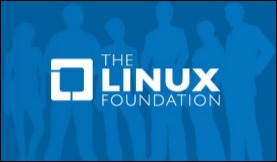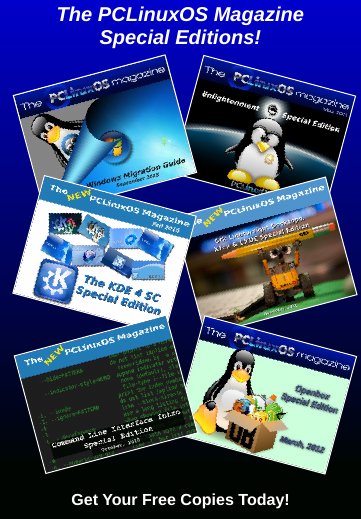| Previous
Page |
PCLinuxOS
Magazine |
PCLinuxOS |
Article List |
Disclaimer |
Next Page |
YouTuber, Part 6: The Epilogue |
|
by Alessandro Ebersol (Agent Smith)  This is the final chapter of the YouTube series, the epilogue. Over the past six months, we talked about various emulators, audio and video programs that help in making videos for YouTube. Here is a recap, in the table below, the list of programs that have been addressed, along with their usefulness.  So examined all these programs that help in creating videos. However, some rules must be followed for sending videos to YouTube, and obviously, to get their monetization. YouTube Rules A special care should be taken with copyrighted material: Licensed music, other video clips that have copyrighted material and the like. The rule of thumb here is: Copyrighted music will always be demonetized. I will return to this subject soon. Other details to watch out for on YouTube are nudity, profanity, and incitement to racial, sexual or religious hatred. In the case of copyrighted songs, the tip is to mute these songs when they appear in the video. Otherwise, you lose the monetization of this video. The so-called Fair Use is somewhat uncertain on YouTube, as there have been several instances of parodies and other uses that would fall on Fair Use, yet the videos have been removed. I'd say it's a very gray area of YouTube, and you can not be sure of anything. However, YouTube is no longer what it was once, and excessive copyright zeal, censorship, and other new rules are hitting small content creators hard. There is something rotten in YouTubeland ... Well, as I mentioned above, copyright strikes are making it harder to work on YouTube. As I mentioned Fair Use, there is no clear rule, and many materials that would fall into this classification, either are removed or are demonetized. Now, YouTube shoots first and asks questions later. First your video is either demonetized or taken off line, and then the merit of the strike is judged. Plus, the Content ID technology is abused by large companies. Even with YouTube creating a "safety net" for creators, it just does not work for large companies, just small copyright trolls. But it's not just that. These same companies, who claim copyright infringement, use the same Content ID tool to silence bad reviews of their products, or when YouTubers raise negative issues about those companies. And, things get worse. Depending on the keywords in your video, YouTube will not monetize your video either, thanks to an advertiser-friendly video policy, which cuts video monetization with controversial keywords. It's clearly done by robots, but it blocks legitimate content, while allowing a lot of bad content to slip through. Copyright Abused ... Copyright laws are completely obsolete and fundamentally broken. To get an idea, let's take a video game (or it could be a movie, too), like the famous game that came out on Playstation 1, Tony Hawk's Pro Skater. There are dozens of songs licensed in this game, such as: The Suicide Machines' "New Girl", Goldfinger's "Superman", Speedealer's "Screamer/Nothing to Me", Dead Kennedys' “Police Truck”, Primus's "Jerry Was a Race Car Driver", among many other famous songs, and the producer, Activision, paid the artists when the game was made. Now, if you make a video gameplay about this game, as the game is, with all its soundtrack intact, YouTube Content ID will flag all the songs, and reverse the monetization to the copyright holders of each one from them. That is, you had the labor of making the game work, captured all the footage, edited the raw material on a program of your own and even uploaded the video, and you will not get anything for it. Meanwhile, the copyright holders will take all the monetization of the video, no sweat nor anything, from all your work. And, the legit authors receive part of that amount, but it depends on the company that manages the rights. It is ridiculous to see how copyright maximalists struggle, to have their rights extended eternally, and at the same time stop cultural evolution. After all, everything that exists is a mashup of things that have already been around. Copyright laws have to be reformed, because today, they serve more large groups, and less the artists and authors, since their income is marginal, while rights groups take the lion's share. But thanks to Disney, things will not change anytime soon (for example, we will have wait for 2023, when Mickey enters into the public domain). But because of these YouTube policies, I do not make videos about this game (Tony Hawk's Pro skater). Logan Paul and the demonetization of the small channels YouTube also struck a heavy blow to small creators in February 2018 with new rules for monetization. After a controversial video from YouTuber Logan Paul, YouTube changed monetization rules. Starting February 20, 2018, only channels that have been viewed for 4,000 hours and have 1,000 unique subscribers in the last 12 months will be able to host ads and share revenue. This is being seen as a significant improvement over the standards introduced last April, which required more followers but did not set a standard for display time. But, anyways, YouTube is penalizing the small creators of content, and favoring the big channels, which have a much more expensive and professional production, production teams and more people working on the videos. No more the solo guy making a video in his room and sending it to YouTube, which is a sad reality, when YouTube tries to suffocate those who have made it such a popular service. The order now is to privilege content said "professional" and advertiser-friendly at the expense of small channels. Sadly, this trend, which has been happening since 2012, and culminated with the clueless videos of Logan Paul, had a hard impact, and was called "adpocalypse." The so-called Adpocalypse was so severe that it led to the famous shooting in San Bruno, California at the headquarters of YouTube. And, YouTube has launched its paid streaming service, YouTube Red, showing more hints of the direction it is following now. Censorship and Content Removal Censorship and content removal also worsened recently, when YouTube began censoring videos that it considers controversial, or, to please the government of certain countries (China, Pakistan and others). The Conclusion As we've seen above, the picture for anyone trying to get into YouTube now is quite disheartening. YouTube is closing the door to the little guys, while trying to become a new Netflix. Nothing against changing and expanding, but one must preserve its initial audience. YouTube today tries, with all its forces, to become a vehicle of communication as a new Fox TV, censoring and shaping its audience. But we live in other times, not in the time of alienation, but of information. It's much harder now, since the genie is out of the bottle, to try to fool everyone again. But, YouTube tries by promoting kitten videos, and alienating content and censoring content it considers controversial. Now who is above good and evil to judge others? Hate speeches are one thing, but opinions are another. And, to what measure does YouTube judge both? Robots mainly, which leads to error. And to make matters worse, YouTube is investing 25 million so that "reliable sources" of "traditional" journalism can take better advantage of its platform, at the same time fighting the so-called fake news. Whoa, traditional media is the biggest maker of fake news, then expect more censorship and removal of content. YouTube, however, made an interesting gesture of goodwill to assist the small channels: The paid subscription, where users have the option to contribute to the channel they subscribe to. And as this "squeeze" in the small channels has been around for some time, creators turn to crowdfunding platforms such as Patreon to keep their earnings and continue with their channels. In fact, this new YouTube policy is very depressing, as many people have come to earn their living from YouTube, taking their livelihood and their family's income from that service. I myself have become accustomed to seeing more of my news channels on YouTube, than the traditional channels(TV's, newspapers, etc…). And, all of this may be threatened now. But, do not fear: there are other options. YouTube is not the only service of its kind out there, and there are new services like D-Tube. D-Tube's look is very similar to YouTube, without the ideological restrictions. And Twitch TV is also accumulating more and more content creators from the YouTube exodus. So if YouTube does not care for and preserve its talented creators, it will end up like traditional media: Just another cable TV channel with a lot of uninteresting content, while its best assets (creators) will have migrated to other services. In the future, I will write about alternatives to YouTube, which exist, and, depending on what you want to do, in artistic terms and expression, can be much better than YouTube. Folks, everything I wrote in this series of articles, I tested in my You Tube channel: https://www.youtube.com/channel/UC84De8g52Z0C5YzubnICzKg So, if you are willing to see everything I wrote about in action, for real, take a look at my channel, and if you feel inclined, subscribe to it. |



